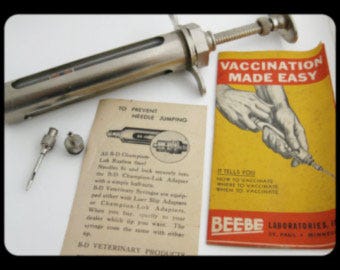Drug-Delivery Systems Take Their Turn in the Spotlight
January 11, 2014
|
Vintage syringe image from etsy.com. |
Many companies and researchers are working on novel ways to improve the delivery of drugs to their targets. Also contributing to this trend is the significant number of blockbuster drugs going off patent and the exploding cost of developing new drugs, both of which are spurring big pharma to look to novel delivery methods to distinguish their products from competitors.
A recent summary of advances in the field can be found in a report from NIH's National Institute of Biomedical Imaging and Bioengineering titled "Drug Delivery Systems: Getting Drugs to Their Targets in a Controlled Manner." While basic, this report provides a comprehensive overview of the field. It may help some narrow their search for an appropriate vehicle or may prove sufficient itself for someone with a casual interest in the subject.
Microneedles, one of the technologies mentioned in the above report, could also be used to probe glucose levels in diabetics. Scientists from North Carolina State University (NC State; Raleigh), Sandia National Laboratories (Albuquerque, NM), and the University of California at San Diego have shown the potential of embedding microneedles with sensors, which could also be used to monitor the pH of blood as well as compounds such as lactate.
Nanotechnology-based drug-delivery technologies could also be used to facilitate targeted delivery of cancer therapeutics. Researchers have investigated a number of different strategies to accomplish this objective, devising, for instance, nanodiamond-based drug-delivery technology to nanosponges that degrade after finding their cancer-cell target.
The topic of drug delivery is also the subject of a new market research report, "Global Markets and Technologies for Advanced Drug Delivery Systems," published by BCC Research (Wellesley, MA). This in-depth report explores present and future strategies within the drug-delivery market. The discussion covers sustained-release drug delivery, prodrug, implants and intrauterine devices (IUDs), targeted drug delivery, polymeric drug delivery, transdermal drug delivery, and transmucosal drug delivery systems. The classification and usage of these types of drug delivery systems, with comparisons among them, are also portrayed in this report. Also covered are significant recent patents in the field.
Applications for various drug delivery systems are also discussed in the report. Emphasis is on the usage of these systems in various therapeutic categories and various disease sectors. The report also covers significant patents and their allotments in each category. The authors have also conducted a detailed analysis of drug delivery industry structure. Revenues are broken down by region, and sales figures are projected for the five-year period from 2013 through 2018.
Those in the field, or with a serious and ongoing interest in the field, may be better served by Advanced Drug Delivery Reviews, a peer-reviewed journal. The aim of the journal is "to provide a forum for the critical analysis of advanced drug and gene delivery systems and their applications in human and veterinary medicine." The journal claims a broad scope and covers key issues for effective drug and gene delivery, from administration to site-specific delivery.
About the Author(s)
You May Also Like


.png?width=300&auto=webp&quality=80&disable=upscale)
